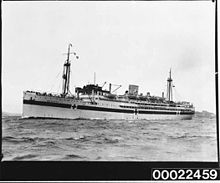Manunda (ship)
|
||||||||||||||||||||||
|
||||||||||||||||||||||
|
||||||||||||||||||||||
|
||||||||||||||||||||||
|
||||||||||||||||||||||
The Manunda was a 1929 passenger ship of the Australian shipping company Adelaide Steamship Company and the largest ship of this shipping company until then. From 1940 to 1945 she served as a hospital ship AHS Manunda (Australian Hospital Ship Manunda ) under Australian flag. Used again as a passenger ship after the war, she was scrapped in Japan in 1957.
Passenger ship
In 1927, the Adelaide-based Australian shipping company Adelaide Steamship Company ordered a 9,119 gross tonnes motor ship from the William Beardmore and Company shipyard in Dalmuir , which was to be put into service for passenger and mail traffic along the Western Australian coast ( Australian coastal passenger service ). The TSMV Manunda (TSMV = Twin Screw Motor Vessel; German twin screw motor ship) was launched on November 27, 1928 and was completed on April 16, 1929. In June 1929 she arrived in Australia after crossing Scotland and began her passenger traffic from Sydney via Melbourne and Cairns to Fremantle .
The Manunda could accommodate 176 first class passengers and 136 second class passengers and drove at a cruising speed of 15 knots. The success of the Manunda prompted the Adelaide Steamship Company to order an even larger, faster sister ship from Alexander Stephen and Sons in 1934 , the Manoora (10,856 GRT), which began service in 1935. Both ships were named after the suburbs of the city of Cairns in Queensland and were among the most popular Australian passenger ships of their time.
Hospital ship

After the outbreak of the Second World War , the Manunda was requested for military service in September 1939 and converted into a Defensively Equipped Merchant Ship (DEMS), roughly “a merchant ship equipped for defense”. It now came under the control of the Australian Shipping Control Board. In Sydney the Manunda was then converted into a hospital ship and handed over to the responsible authorities on May 25, 1940. On July 22, 1940 she was put into service as AHS Manunda (Australian Hospital Ship). The new commanding officer was Captain James Garden. The hospital staff stationed on board was Lieut. Colonel John Beith in front and the nurses from the Australian Army Nursing Service (AANS) were under the direction of Head Nurse Clara Jane Schumack.
On her first voyage as a hospital ship, the Manunda went to Darwin and Port Moresby and then returned to Sydney. Between November 1940 and September 1941 she made a total of four crossings to the Middle East and the Mediterranean before she was relocated to Darwin. On January 14, 1942, the Manunda arrived in Darwin after a seven-day voyage from Darling Harbor . Over the next five weeks that the ship was there, routine measures were carried out and rescue exercises carried out. The hospital staff also visited surrounding hospitals. On February 15, 1942, they learned there of the surrender of Singapore .
On the morning of February 19, 1942, the ship was also the target of the heavy Japanese air raid on Darwin , in which over 200 people were killed and eight ships were sunk in the port. AHS Manunda was narrowly missed by a shell , but the explosion caused shrapnel to rain all over its deck. Later, 76 impact holes were counted in the ship's side that were caused by these fragments. A bomb narrowly missed the bridge , but penetrated the skylight of the music room and exploded at the height of the C-deck, where they killed several people and injured. Fires broke out in several places on board and the medical staff's quarters were completely destroyed. There were 15 deaths among the crew and nursing staff on board the Manunda , including the third officer, the deputy purser and a nurse. 18 people were seriously injured and around 40 slightly injured. Head nurse Clara Schumack was in shock as a result of the attack, but still monitored the care of the injured. She was later awarded the Royal Red Cross for her behavior . Captain Garden received the Order of the British Empire for his command of the ship .

The Manunda was lucky compared to other ships in the port of Darwin, she was not sunk. Although it was damaged, after the attack it still served as a rescue station for the wounded from other ships. She returned to Fremantle with 266 wounded. After it was restored in Adelaide, it was used in Milne Bay in Papua New Guinea as a hospital ship for the Allied forces stationed there. From Milne Bay, the Manunda made a total of 27 crossings to Brisbane and Sydney. It was then used in the Pacific wherever the armed forces needed it.
After Japan's surrender , the Manunda was sent to Singapore in September 1945 to pick up former prisoners of war and interned civilians from the Changi POW camp . For the same purpose, she went to Labuan , Borneo , to return prisoners of war and civilians who had been interned in the Batu Lintag prisoner of war camp until then.
In September 1946 the Manunda was released from the service of the Australian Navy and underwent an intensive 18-month renovation in Melbourne. On April 2, 1948, her first post-war voyage began with civilian passengers along the Australian coast. In September 1956, the 27-year-old ship was decommissioned by the Adelaide Steamship Company and sold by Okadagumi Shipping Ltd. bought from Japan. Under the name TSMV Hakone Maru , she left Sydney for the last time on October 4, 1956. On June 18, 1957, the ship arrived in Osaka for scrapping .
literature
- Rupert Douglas Goodman. Hospital Ships. Manunda, Wanganella , Centaur , Oranje . Boolarong Publications, Brisbane 1992, ISBN 0-86439-139-0 .
- Barry Pemberton: Australian Coastal Shipping . Melbourne University Press, Carlton 1979, ISBN 0-522-84131-7 .
